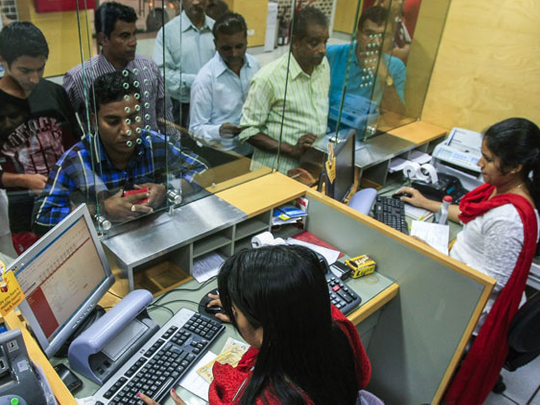
Fueled by the strengthening of the dollar over Asian currencies, money flows from the UAE to the developing countries, including India, continued to grow in 2014, with transfer operators reporting up to 15 per cent increase in transactions.
Exchange houses in the UAE reported that last year’s top performing markets were India, Pakistan, Bangladesh and the Philippines, which attracted the bulk of remittance flows from the UAE.
The growing influx of expatriates seeking job opportunities in the Middle East, improving economic prospects in Asian countries,rising deposit interest rates in some expatriates’ home countries and the relatively low cost of sending money from the UAE have also created a positive impact on money flows.
Promoth Manghat, vice president, global operations at UAE Exchange, said remittances from the UAE to developing countries increased by 8 to 10 per cent between 2013 and 2014. He said that more expatriates increased their remittances last year due to “favorable” exchange rates.
“Good exchange rate due to the depreciation in some currencies in the developing world, improvement in the interest rates of foreign currency non resident deposits in countries like India, further brightening up of economies in the developed nations are some of the major factors that have made a positive impact on remittances,” Manghat told Gulf News.
“There has been a slight dip in some of the currencies in the developing world against the UAE dirham or US dollar. This would have naturally encouraged expatriates to send more money home in 2014 as they could get better exchange rates,” he added.
The World Bank estimated that money flows to developing countries were forecast to reach $435 billion in 2014, an increase of 5 per cent over 2013.
India, which has about 14 million migrants around the world, topped the global chart, attracting about $71 billion. Other large recipients were China ($64 billion), the Philippines ($28 billion), Mexico ($24 billion), Nigeria ($21 billion), Egypt ($18 billion), Pakistan ($17 billion), Bangladesh ($15 billion), Vietnam ($11 billion and Ukraine ($9 billion).
“Remittances remain an especially important and stable source of private inflows to developing countries, as they bring in large amounts of foreign currency that help sustain the balance of payments,” the World Bank said in its report.
Sudhesh Giriyan, COO at Xpress Money, which operates in about 150 countries, said their top performing markets are India, Pakistan, Bangladesh and Philippines. Other markets, like Indonesia and Africa, are also growing aggressively.
Giriyan said outward remittances from the UAE went up by 15 per cent last year, driven in part by the strengthening of the US dollar against many Asian currencies.
“The rise in remittances is also due to the number of festivals that expatriates observe. The second half of the year, particularly during popular festivals like Onam or during the Christmas season, we tend to see our numbers really go up,” he said.
“Also, whenever the US dollar or the UAE dirham appreciates against the Indian rupee or other currencies, there’s a tendency for certain expats, especially those in the white-collar segment, to send more money. The blue-collar workers, on the other hand are forced to send money every month, regardless of the exchange rate because they have dependents back home,” Giriyan told Gulf News.
The cost of sending money from the region, particularly between UAE and Pakistan, is considered one of the cheapest in the world, according to the World Bank. Globally, sending money costs an average of 7.99 per cent of the amount sent.
Remittance cost for UAE to Pakistan stands about 2.23 per cent of $200 sent, compared to 21.13 per cent for South Africa to Malawi.







